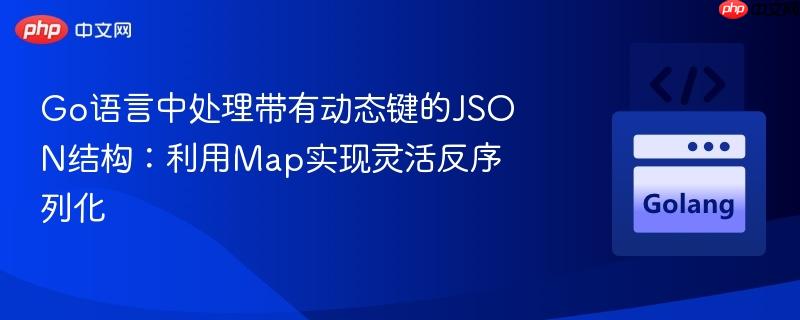
在go语言中处理json数据时,我们通常会将json对象映射到预定义的结构体(struct)。然而,在某些场景下,json对象的键名并非固定,而是根据实际数据动态生成。例如,以下json结构中的image_urls字段:
{
"items": [
{
"name": "thing",
"image_urls": {
"50x100": [
{
"url": "http://site.com/images/1/50x100.jpg",
"width": 50,
"height": 100
}
],
"200x300": [
{
"url": "http://site.com/images/1/200x300.jpg",
"width": 200,
"height": 300
}
],
"400x520": [
{
"url": "http://site.com/images/1/400x520.jpg",
"width": 400,
"height": 520
}
]
}
}
]
}在这个例子中,image_urls 对象包含 "50x100", "200x300", "400x520" 等键,这些键代表了不同的图片尺寸。这些尺寸键是动态的,可能在不同的响应中出现更多或更少的尺寸。如果尝试为每种可能的尺寸定义一个结构体字段,例如:
type Images struct {
FiftyXOneHundred []ImageURL `json:"50x100"` // 这种方式无法穷举所有可能
// ... 更多尺寸字段
}这种方法显然不可行,因为它无法应对未知或变化的键名。我们需要一种更灵活的方式来处理这种动态性。
Go语言的map类型是处理动态键名JSON的理想选择。map[string]T 可以将任意字符串键映射到指定类型T的值。对于上述image_urls的场景,每个尺寸键对应的值都是一个ImageURL结构体数组。因此,我们可以将image_urls字段定义为 map[string][]ImageURL。
首先,定义单个图片URL的结构体:
立即学习“go语言免费学习笔记(深入)”;
type ImageURL struct {
URL string `json:"url"`
Width int `json:"width"`
Height int `json:"height"`
}然后,为包含动态image_urls的Item结构体定义如下:
type Item struct {
Name string `json:"name"`
ImageURLs map[string][]ImageURL `json:"image_urls"` // 使用map处理动态键
}最后,如果JSON根是一个包含items数组的对象,我们还需要一个顶层结构体:
type Response struct {
Items []Item `json:"items"`
}通过这种方式,json.Unmarshal 能够自动将JSON中image_urls下的所有动态键值对解析到map[string][]ImageURL中,无论键名是什么,也无论有多少个键。
以下是一个完整的Go程序示例,演示了如何解析包含动态键的JSON数据:
package main
import (
"encoding/json"
"fmt"
)
// ImageURL 定义单个图片URL及其尺寸信息
type ImageURL struct {
URL string `json:"url"`
Width int `json:"width"`
Height int `json:"height"`
}
// Item 定义包含动态图片URL的单个项目
type Item struct {
Name string `json:"name"`
ImageURLs map[string][]ImageURL `json:"image_urls"` // 使用map[string][]ImageURL处理动态键
}
// Response 定义整个JSON响应的顶层结构
type Response struct {
Items []Item `json:"items"`
}
func main() {
jsonData := `{
"items": [
{
"name": "thing",
"image_urls": {
"50x100": [
{
"url": "http://site.com/images/1/50x100.jpg",
"width": 50,
"height": 100
},
{
"url": "http://site.com/images/2/50x100.jpg",
"width": 50,
"height": 100
}
],
"200x300": [
{
"url": "http://site.com/images/1/200x300.jpg",
"width": 200,
"height": 300
}
],
"400x520": [
{
"url": "http://site.com/images/1/400x520.jpg",
"width": 400,
"height": 520
}
],
"custom_size_1": [
{
"url": "http://site.com/images/1/custom.jpg",
"width": 100,
"height": 150
}
]
}
}
]
}`
var resp Response
err := json.Unmarshal([]byte(jsonData), &resp)
if err != nil {
fmt.Println("Error unmarshaling JSON:", err)
return
}
fmt.Printf("Parsed Response: %+v\n", resp)
// 访问解析后的数据
if len(resp.Items) > 0 {
item := resp.Items[0]
fmt.Printf("\nItem Name: %s\n", item.Name)
fmt.Println("Image URLs by Size:")
for size, urls := range item.ImageURLs {
fmt.Printf(" Size: %s\n", size)
for _, img := range urls {
fmt.Printf(" URL: %s, Width: %d, Height: %d\n", img.URL, img.Width, img.Height)
}
}
// 尝试访问一个特定的动态键
if urls, ok := item.ImageURLs["50x100"]; ok {
fmt.Printf("\nAccessing '50x100' images directly:\n")
for _, img := range urls {
fmt.Printf(" URL: %s, Width: %d, Height: %d\n", img.URL, img.Width, img.Height)
}
}
}
}运行上述代码,你将看到JSON数据被正确解析,并且可以通过遍历map来访问所有动态尺寸的图片链接。
通过本教程,我们学习了在Go语言中如何优雅地处理包含动态键的JSON数据。核心思想是利用Go的map类型(特别是map[string]T)来映射那些键名不固定的JSON对象。这种方法不仅能够有效解决结构体字段无法穷举所有可能键名的问题,也使得JSON反序列化过程更加灵活和健壮。在实际开发中,理解并恰当运用map来处理动态JSON结构是Go开发者必备的技能之一。
以上就是Go语言中处理带有动态键的JSON结构:利用Map实现灵活反序列化的详细内容,更多请关注php中文网其它相关文章!

每个人都需要一台速度更快、更稳定的 PC。随着时间的推移,垃圾文件、旧注册表数据和不必要的后台进程会占用资源并降低性能。幸运的是,许多工具可以让 Windows 保持平稳运行。




Copyright 2014-2025 https://www.php.cn/ All Rights Reserved | php.cn | 湘ICP备2023035733号